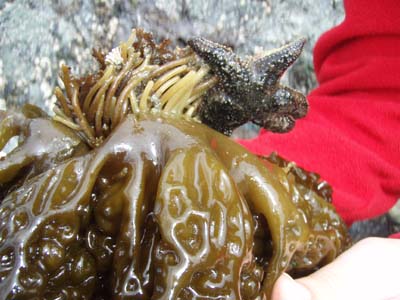
Ecology
Saccharina sessile and Leptasterias at Deadman's Bay
Limpets, a tube worm and cencrusting corallinne algae found under a sea cabbage removed from the rock at Deadman's Bay
Katharina tunicata, snails, hermitcrabs found under a sea cabbage at low tide at Deadman's Bay |
Saccharina sessile is a dominant member of the low intertidal, especially where there are few urchins. Paine and Vadas (1969) found when sea urchins (Strongylocentrotus spp.) were experimentally removed S. sessile became the dominant algal species. Thus herbivory plays a major factor in controlling the growth and proliferation of the sea cabbage (11). Saccharina sessile is especially important ecologically because it can form a dense canopy and protect other animal and algal species from dessication (10). The sea cabbage is commonly a protective canopy for many small animals including: the leather chiton (Katharina tunicata), hermit crabs, barnacles, snails, limpets, tube worms, and the 6-armed sea star (Leptasterias spp.) as well as encrusting coralline algae. (see photos) The black leather chiton (Katharina tunicata) grazes substantially on this kelp, especially on the holdfasts of young kelp (10). The sea cabbage can grow 5-10% per day in actively growing regions and may exhibit rapid changes in morphology. It is a perennial kelp and can live up to three years (10). Experiments have shown the sea cabbage to be very thermally sensitive, only withstanding water temperatures up to 15°C (10).
|
(10) O’Clair, Rita and Sandra C. Lindstrom. North Pacific Seaweeds. Plant Press. Auke Bay, AK: 2000.
(11) Paine, R. T. and R. L. Vadas. 1969. The effects of grazing by sea urchins Strongylocentrotus spp. on benthic algal populations. Limnology and Oceanography. 14: 710-719.


